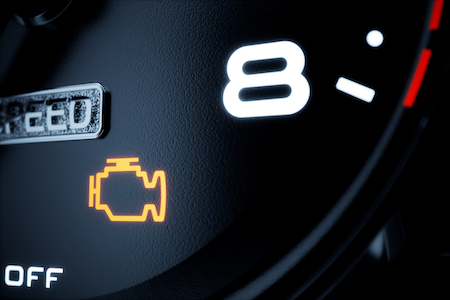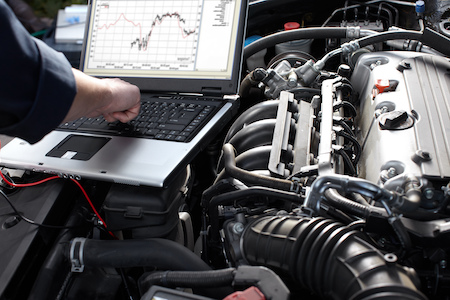You start up your car. The dashboard lights illuminate. One of them stays on. Now what?
Check engine lights can signal you have a major vehicle issue. It can also be the sign of something minor – something you’ll have to fix eventually, but won’t impact your current drive.
Minor issues could include:
- A bad oxygen sensor
- Faulty spark plug wires
- A loose fuel cap
- Faulty mass airflow sensor
These are drivable issues. You should fix the problem or schedule an appointment with your mechanic at your earliest convenience.
Major issues could include:
- A coolant system malfunction
- A fuel injector problem
- A faulty catalytic converter
- Engine failure
These are all major issues. Continued driving will only further impact your car, possibly to the point of it ceasing altogether.
But how do you know the difference? Because a check engine light can mean so many things, how do you know what to do?
How to determine if it’s safe to drive with the check engine light on
When any light illuminates on your dashboard, it’s a sign of a potential problem. Should you turn the car off immediately? Do you have time to drive to your mechanic? Can it wait several days until you can schedule an appointment? There are three things you can do.
1. Pull over and turn off the engine as soon as possible. This may reset the icons and cause the check engine light to turn off. If it still illuminates, do any other icons light up? For example, a low oil pressure light with the check engine light might signal overheating issues. Have you noticed it in the way your car drives? Is there smoke coming up from the hood of the vehicle? This is your time to become aware of what your vehicle is trying to tell you.
2. Check your gas cap. If you’ve recently refueled, it’s time to pull over and adjust your gas cap to ensure it’s tightly in place. This is a common problem, and the check engine light can take several restarts to reset. This light comes on whenever it detects a leak in the emissions system, which can occur if the gas cap isn’t tightly sealed. Be aware that newer models occasionally will also have a gas cap indicator on the dashboard.
3. Reduce speed and load. The check engine light may come on as you drive in and out of the mountains. We see this a lot here in Colorado. The check engine light warns you to lower your speed and take it easy on the engine. If you’re towing anything or have a heavy low, you should try and unload it as soon as possible to avoid potential repairs. You should also have it quickly inspected to find out what maintenance items should be fixed.
Is it safe to drive when the check engine light is on?
We hear you – even with the above steps in mind, the check engine light seems like a good indicator of something wrong with your vehicle.
And we agree – why chance it? Your engine is one of the most expensive components of your vehicle. Engine failure can run well into the thousands of dollars for repair. It’s easier to assume the worst and get your car inspected quickly as soon as you discover the check engine light stays illuminated.
The check engine light is an indicator that there may be a problem with your vehicle’s engine or emissions system. The light could indicate something as simple as a loose gas cap or something more severe as a malfunctioning sensor or catalytic converter.
If the light is flashing, it usually means a more severe problem needs immediate attention. In newer cars, your check engine light may have two colors – yellow and red – with the red light indicating a more severe problem. Continuing to drive with a flashing or red check engine light could cause damage to your engine or emissions system and even result in your vehicle stalling or not starting.
It is best to have your vehicle inspected by a qualified mechanic as soon as possible to determine the cause of the check engine light and address any issues before they become more serious and potentially expensive to repair.
A brief summary of check engine light potential problems
If your check engine light is on, it’s probably one of these things:
Oxygen sensor failure – The oxygen sensor measures the amount of oxygen in your vehicle’s exhaust. If it fails, it can cause your car to run less efficiently and potentially damage your catalytic converter.
Loose gas cap – A loose or missing gas cap can cause fuel vapors to leak out of your vehicle’s fuel system and cause your check engine light to turn on.
Catalytic converter failure – A faulty catalytic converter can cause your vehicle to run poorly and potentially damage other components of your vehicle’s emissions system.
Spark plug issues – Worn spark plugs can cause the engine to misfire or run poorly, triggering the check engine light.
Mass airflow sensor failure – Mass airflow sensor failure can cause your engine to run less efficiently and potentially stall or not start.
Vacuum leak – A cracked or loose connection in one of the hoses that control the air and fuel mixture in your engine can cause your engine to run poorly and trigger the check engine light.
Exhaust gas recirculation valve failure – Exhaust gas recirculation (EGR) valve failure can change the emissions system functionality, which can cause your engine to run poorly and potentially damage other components of your vehicle’s emissions system.
Dead battery – A weak or dead battery can cause the check engine light to turn on.
Is your check engine light on?
You might think, “I don’t have time,” or “It’s probably not that big of a deal.” It is.
Your check engine light is one of the most important dashboard lights you should keep an eye out for.
If yours is illuminated, schedule an appointment today. We’ll have you back on the road quickly.


